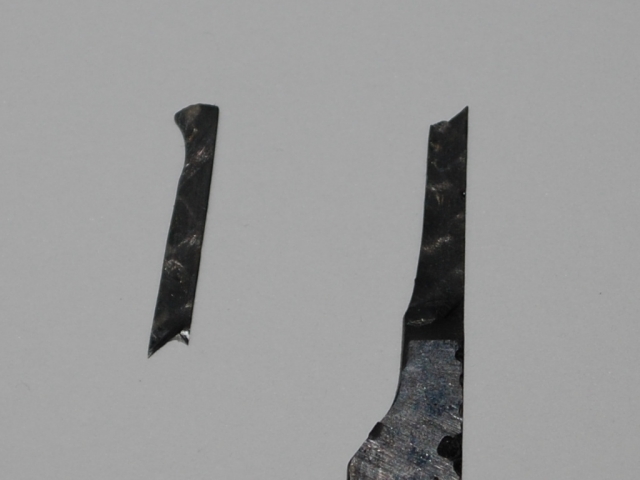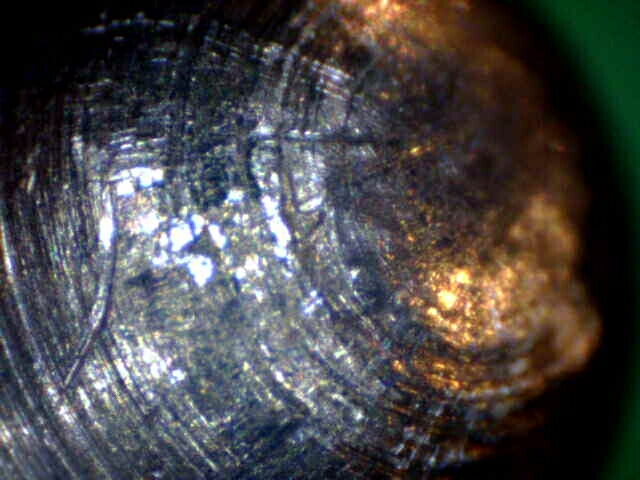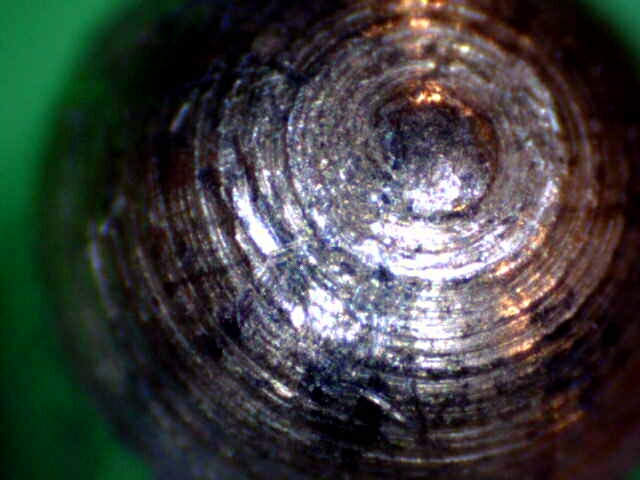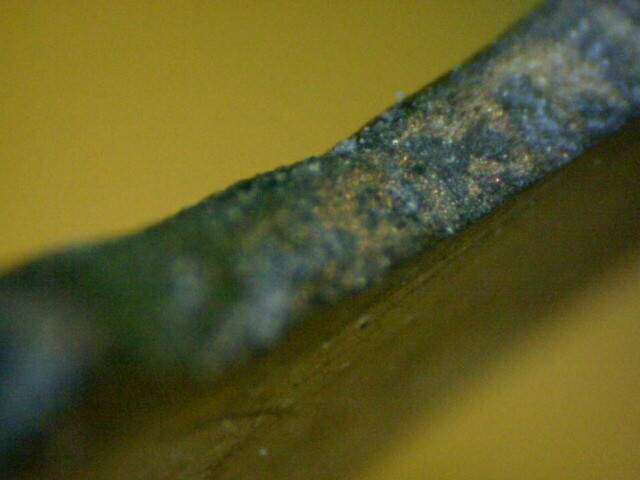|
When it comes down to it there is nothing better than manual tools for your Lock pick Set, whether they be retail, homebrew, macgyver style. DIY'ers look here.
 by datagram » 11 May 2009 10:22 by datagram » 11 May 2009 10:22
So, I spent the weekend trying several types of materials for anti-forensics lockpicks. There have been many discussion on LP101 about carbon fiber and how good it would be as a pick material, its possible applications in anti-forensics, etc. Turns out: not surreptitious as many had hoped, and not very good, in general. Here is the picture of a finished carbon fiber lockpick:  At first use it seemed very good as a lockpick. Horiztonal strength was somewhat weak but it had great vertical strength, which is what we're looking for in a pin-tumbler lockpick. It successfully picked a lock, but on the second try (to verify any forensic info) this happened:  Sucks! The good news was that I got to try it with two locks, and I'm sure it would have been able to pick the second lock if it held up. SO, with two locks to look at my focus shifted to forensic evidence. Surely a one-time use pick would be excellent, but only if it left no forensic evidence. The following are pins 1 and 5 of the first lock:   Wah wah wahhh. Both shows clear signs of lockpicking just like traditional metal tools, though admittedly they have a slightly different look to them. The other pins from this and the second lock show similar marks, but no real point showing them all. In addition, examination of the pick shows this:  That is, in fact, brass from that pins that has rubbed off onto the pick. Yet another way this could contribute to linking a suspect to a crime, esp if pin material is some form of proprietary alloy. All in all, seems that CF won't be replacing the trusty steel picks anytime soon. The hunt continues! Future work will be with fiberglass, glass, brass, and ceramics (and anything else you'd want to suggest that I haven't already tried!). It is very possible that I am leaving something out that would make these great tools. If you have any input post here, PM me, or email me (contact details on site). For more info on forensic locksmithing: http://www.lockpickingforensics.comdg
-
datagram
-
- Posts: 873
- Joined: 1 Aug 2005 0:49
- Location: Los Angeles, CA
-
 by jamesphilhulk2 » 11 May 2009 15:30 by jamesphilhulk2 » 11 May 2009 15:30
im happy to see that someone made the Carbon Fibre pick, i don't hold much hope for glass as another lock pick material, personally i would focus my efforts on plastic lock picks there are loads of different plastics with various strengths and weaknesses
-
jamesphilhulk2
-
- Posts: 528
- Joined: 5 Jul 2005 4:37
- Location: S.Wales, uk
 by ToolyMcgee » 11 May 2009 21:23 by ToolyMcgee » 11 May 2009 21:23
I do alot less damage with steel and a light touch. It looks like the fiber pick was absolute sand paper. Honestly not very suprising, but it is cool to see someone actually finish a project instead of presenting an idea they never intend to follow up on. No matter the result, it's a successful test. Great pictures.
-Tooly
*blank*
-
ToolyMcgee
-
- Posts: 640
- Joined: 27 May 2008 14:45
- Location: Indiana
 by lunchb0x » 11 May 2009 22:12 by lunchb0x » 11 May 2009 22:12
to not leave any evidance wouldn't you need it to be made of something softer than the pins, how about a normal slimline pick with some sort of coating like powder coating? by the time the paint has chipped of the tip of the lock hopefully the lock has been open, or even having a brass tip on the pick?
-
lunchb0x
- Supporter

-
- Posts: 1227
- Joined: 25 Nov 2006 12:10
- Location: Australia
 by l0ckp1cker » 12 May 2009 5:17 by l0ckp1cker » 12 May 2009 5:17
Shapes could help a lot as well. I will see if I can try some shapes to see what would be the best result  07JAN2017: - Back on the board again 
-
l0ckp1cker
-
- Posts: 222
- Joined: 1 Apr 2009 9:20
- Location: The Netherlands
 by raimundo » 12 May 2009 13:49 by raimundo » 12 May 2009 13:49
Take a normal hook and use it like a solder pick on a ball of brazing rod. this should give you a steel shaft with a ball of brass on the pick tip.
a brass ball pick tip should make marks indistinguishable from the keys marks, The shaft of the hook pick should be shined up so it has no sharp edges or friction.
Wake up and smell the Kafka!!!
-
raimundo
-
- Posts: 7130
- Joined: 21 Apr 2004 9:02
- Location: Minnneapolis
 by datagram » 12 May 2009 15:54 by datagram » 12 May 2009 15:54
Good suggestions from everyone, but remember that for it to be truly anti-forensics it can't leave marks in the plug, either. Coating and modified tips don't work because the sides of the pick will make marks in the plug and possibly the sides of pins (think of the extreme MACS high-low combinations).
In some of the tests I did coating hasn't been doing very well, at least not to the point that the coating itself isn't leaving evidence, either. I'll be making the fiberglass pick this weekend, and trying some other stuff, hopefully.
dg
-
datagram
-
- Posts: 873
- Joined: 1 Aug 2005 0:49
- Location: Los Angeles, CA
-
 by barbarian » 12 May 2009 18:38 by barbarian » 12 May 2009 18:38
Just a thought. Could you laminate brass/stainless/brass ? Maybe .010" thick sheets of each.
If the stainless was trimmed a bit smaller it would give the stiffness without touching the pins.
-
barbarian
-
- Posts: 258
- Joined: 28 Jun 2007 18:06
 by bluefish6900 » 18 May 2009 16:57 by bluefish6900 » 18 May 2009 16:57
Is it possible to have an alloy back bone and a nylon/teflon coating, only the contact areas need to be softer then the plug/pins. A rubber tip could also be added. Only problem would be trying to work at the tight sizes. I'm sure it would be possible.
-
bluefish6900
-
- Posts: 43
- Joined: 23 Feb 2009 20:46
- Location: Halifax, Nova Scotia
 by FarmerFreak » 18 May 2009 19:40 by FarmerFreak » 18 May 2009 19:40
I know that your idea is to be able to pick a lock and leave zero forensics info behind. But wouldn't it be simpler to just impression a key? Assuming that you cleaned the brass dust off of the key before inserting it into the lock each time, would there any evidence left behind that couldn't be explained by regular wear and tear? But if you want to stick with picking the lock. As the others have suggested, use something softer than the pins/lock cylinder. But also, you could possibly use a small vacuum to clean out the lock when finished picking 
-
FarmerFreak
-
- Posts: 737
- Joined: 21 Apr 2009 11:58
- Location: SLC, Utah
 by TigerDragon » 18 May 2009 19:51 by TigerDragon » 18 May 2009 19:51
FarmerFreak wrote:I know that your idea is to be able to pick a lock and leave zero forensics info behind. But wouldn't it be simpler to just impression a key? Assuming that you cleaned the brass dust off of the key before inserting it into the lock each time, would there any evidence left behind that couldn't be explained by regular wear and tear? But if you want to stick with picking the lock. As the others have suggested, use something softer than the pins/lock cylinder. But also, you could possibly use a small vacuum to clean out the lock when finished picking 
I would think that impressioning would show markings from the pins/wafers where pressure was applied during the impressioning process, and that this would look different from normal wear and tear. You are binding the pins/wafers with enough force to keep them held in place so that they can cause an impression on the key blank. This would show some markings inside the plug / casing from bound pins/wafers, and on the pins/wafers themselves at the casing/plug and tip (where they rub the key blank) is my assumption.
-
TigerDragon
-
- Posts: 104
- Joined: 22 Jun 2007 10:45
- Location: Conway, Arkansas, USA
 by datagram » 18 May 2009 23:37 by datagram » 18 May 2009 23:37
TigerDragon wrote:I would think that impressioning would show markings from the pins/wafers where pressure was applied during the impressioning process, and that this would look different from normal wear and tear. You are binding the pins/wafers with enough force to keep them held in place so that they can cause an impression on the key blank. This would show some markings inside the plug / casing from bound pins/wafers, and on the pins/wafers themselves at the casing/plug and tip (where they rub the key blank) is my assumption.
http://www.lockpickingforensics.com/impressioning.php  Thanks for changing the topic title, unlisted. I have tested and examined fiberglass and brass lockpicks, will post info before the weekend! dg
-
datagram
-
- Posts: 873
- Joined: 1 Aug 2005 0:49
- Location: Los Angeles, CA
-
 by datagram » 18 May 2009 23:56 by datagram » 18 May 2009 23:56
bluefish6900 wrote:Is it possible to have an alloy back bone and a nylon/teflon coating, only the contact areas need to be softer then the plug/pins. A rubber tip could also be added. Only problem would be trying to work at the tight sizes. I'm sure it would be possible.
Teflon coated/based picks aren't surreptitious, they "polish" the pins in the places that steel normally scrapes, similar to what the carbon fiber did above. Unfortunately, I don't have an example microscopy image...yet. dg
-
datagram
-
- Posts: 873
- Joined: 1 Aug 2005 0:49
- Location: Los Angeles, CA
-
 by FarmerFreak » 19 May 2009 8:08 by FarmerFreak » 19 May 2009 8:08
Thanks for the link Datagram. I didn't think about marks left on the side of the pins. I had only thought about the bottom of the pin. And I figured you wouldn't be able to tell the difference simply from the bottom of the pin.
While I was looking through some of the forensics evidence I noticed something that should probably be considered. In the examples I was looking at (key bumping/impressioning) I noticed that you are using new locks. And not used locks. Now I understand that this would make it easier to find marks left behind from whatever methods you are using to open the locks. But Does this information really transfer over to real world applications? For example key bumping will leave a smooth dented spot on the bottom pin. But if a lock has been in use for at least a year. Wouldn't it have similar smooth/dented spots on the key just from regular use?
Maybe I'm getting off subject. If you have already talked this over with other people please post a link so I can read it. Thanks.
I could search this and I probably will later, but right now I'm off to work.
-
FarmerFreak
-
- Posts: 737
- Joined: 21 Apr 2009 11:58
- Location: SLC, Utah
 by raimundo » 19 May 2009 9:00 by raimundo » 19 May 2009 9:00
The idea that you could forensicly tell with absolute certainty that a lock has been picked, would really also need to establish when the lock was picked, that is were these marks there from last year, or yesterday.
If one were to wish to pick a lock and make it impossible to prove, you could just bring a nickel silver key of that keyway and just scrub the lock and any that may also be examined for comparison. This would probably remove the marks on the tips of the pins, which are not deep if you intended not to leave marks, meaning that you used well sanded picks and light picking technique.
If a lock has been impressioned, you can see an exaggerated large smear on the front of the plug where the shoulder has rubbed hard during the impressioning.
If your lock was fitted well to a wooden door and now is suddenly feeling like the screws have loosened, you should look for this smear, and for brass filings at the nearest place that has a supportive surface and light, (window sill)
locks loosen if impressioned, this is particularly true of rim cylinders and modern morticed deadbolts, but not of mortice locks that have the screw in cylinders and the set screw.
Wake up and smell the Kafka!!!
-
raimundo
-
- Posts: 7130
- Joined: 21 Apr 2004 9:02
- Location: Minnneapolis
Return to Lock Picks
Who is online
Users browsing this forum: No registered users and 11 guests
|








